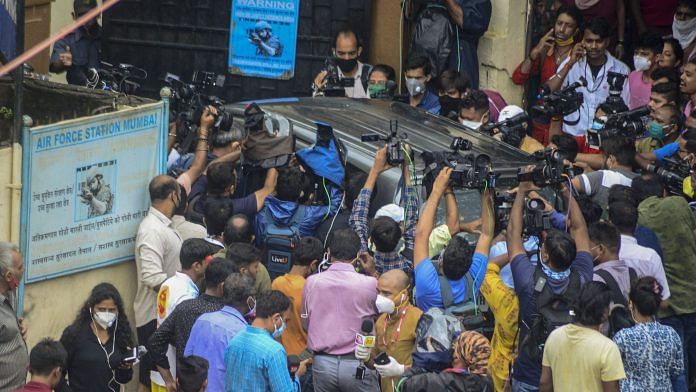New Delhi: The Bombay High Court issued guidelines to regulate media coverage of ongoing criminal cases after hearing multiple PILs on ‘trial by media’ in regard to coverage of actor Sushant Singh Rajput’s death. In episode 665 of Cut The Clutter, ThePrint’s Editor-in-chief Shekhar Gupta decodes how the court has unfairly generalised the entire media for the actions of a few TV news channels.
Gupta says that he found Bombay High Court’s order ‘problematic’ yet ‘significant’. The whole situation reminds him of a Hindi metaphor, ‘Tabela ki bala bandar ka sar’. Gupta explains, “This means when someone else is given the wrath for someone else’s crimes or errors.”
The two-judge bench of the Bombay High Court comprising Chief Justice Debankar Dutta and Justice GS Kulkarni, gave this order. “In this order, they spoke about media trials, contempt law. They’ve also answered the question of whether the contempt law can be used against media organisations which seem to be conducting trial by the media,” he explained.
The judges also read out some ‘limitations’ on freedom of speech. Gupta quoted some paragraphs from the judgement, “What resonates in our ears now is whether the rights guaranteed under Article 19 1A is the most abused in recent times.”
Article 19 1A guarantees freedom of speech and expression. Typically, when we find that whoever is denying us this right, we go to the courts. Historically, the courts have always weighed in on the side of freedom of speech. “…a High Court as reputed as Bombay High Court, (is) actually saying that it appears to them that freedom are being misused — that is a chilling thought,” Gupta adds.
The Court said this is a reminder of what has, at times, become the ‘unsavoury’ part of the press in India, and referred to two TV channels, Republic TV and Times Now.
“It just so happens, one those supreme ironies, both channels were doing exactly the same thing in the Rajput case. They were both in a mad race to call his death an organised murder and blame as many celebrities as possible, including actor Rhea Chakraborty,” Gupta said.
The judges also pointed out that the media is becoming the investigator and the prosecutor. Gupta maintains that while the judges are correct about the claim, not all media houses are doing that.
“My concern is the court saying the media is doing it — you use the same broad brush and paint all of us with the same wretched, stinking black paint,” he said. This generalisation is ‘worrying’. The judges said that the media started a vicious campaign against Rhea Chakraborty. The media gave its verdict that she was guilty of orchestrating Rajput’s murder. The court said that this was prima facie contemptuous . “The law is that from the moment an FIR is filed, the case is sub judice. …So from the moment FIR is filed, a case is sub judice and when journalists cover it, they have to be mindful of the fact that there is a presumption of innocence,” Gupta added.
He explained that it looked like the court, which is an institution supposed to protect our freedoms, is giving an “agenda” to the State to curtail our freedoms. “Why is that being done? That’s being done because of the nonsense done by a couple of channels,” he said.
The court also said that the media, in future, will not insinuate anything about the character of the victim. They should not interview either the victim in the case or witnesses or family members. The judges also pointed out that the media is wrong to criticise the investigative agency. Without proper research, the media shouldn’t recreate a crime scene either.
TRP business
The court had objections to guests on TV channels who say troublesome things.
“But TV channels invite these people because they give cheap thrills to their audiences, that is built around the whole TRP business,” said Gupta.
TV channels make sure they have “BARC in their pocket which guarantees TRP”. Then, channels do ‘sensationalist’ and ‘nonsensical’ stuff which gives TRPs to begin with.
The High Court is using this case to paint all of us as “dishonest, sensationalist, judges, juries, executioners, etc.”
Gupta concluded by saying that the channels doing this are the most successful, but because of them all media houses are being publicly punished. The Bombay High Court should be punishing these particular channels, holding them in contempt.
Also read: Dear viewer, you supported Rhea Chakraborty’s media trial. Republic TV, Times Now TRPs show






